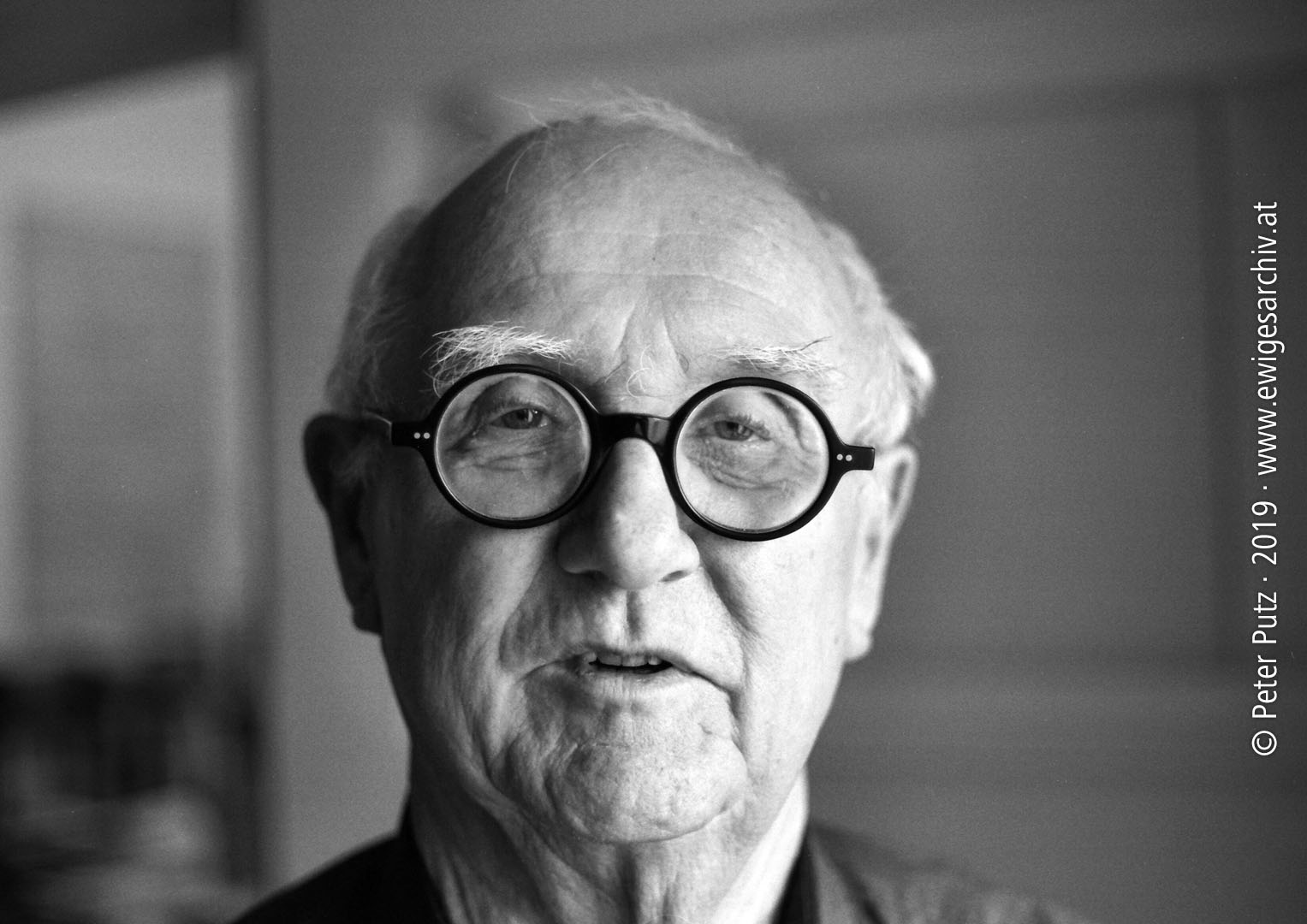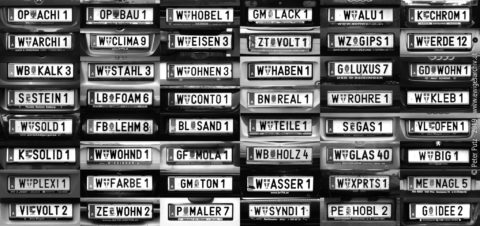
Soweit noch nicht in der Globalisierung der Autokennzeichnung abstrakte Ziffern- und Buchstabensysteme praktiziert werden, kommen sich Städte und Regionen, die nichts miteinander zu tun haben, oft zum Verwechseln nahe. Aber das ist nicht das Thema. Die elektonische Wahrnehmung ist schon lange nicht mehr vom Auge des Polizisten abhängig, und so kann man nicht mehr Milano mit Mistelbach verwechseln.
An die Wunschkennzeichen, eine austrakische Spezialität (?), hat man sich gewöhnt. Als sie im Stadtbild auftauchten, brachten sie etwas Erfrischendes in den Zeichenmüll der verwalteten und umworbenen Welt. Zum „verbuchstabierten Netz“ der Länder, Regionen und Städte kam etwas Neues hinzu, sozusagen eine private, ja intime Ebene. Der Eitelkeit der Schlittenkapitäne waren keine Grenzen mehr gesetzt. besonders beliebt hinter Kose- und Spitznamen war die Nummer 1. „LAUSI 1“ konnte nur aus Klagenfurt stammen. Da war gleich der Klausi mit im Spiel. Wer ihn kannte war gerührt, freute oder ärgerte sich. „GAGGI 1“ war wiederum für eine besondere Art der Fantasie gedacht. Manches stürzte in Tautologisches ab: „FIRST 1“, na ja, ein Zimmermann wirds schon nicht sein. Es outeten sich auch Selbstironiker: „NARR 1“, „WEDL 1“, „ASS 1“, „PROF 1“ (gnadenlos). Eine höhere Stufe (in Nähe der „konkreten poesie“) erreichten zweideutige Verbindungen mit den Kennbuchstaben der Städte, etwa „W & EDEL“. Da führte in der Kombination das Wunschdenken direkt in die harte Wirklichkeit über. Es gibt auch intelligente Konstellationen: „REIF 1“ = Reifenhändler mit Matura. Hat ein „JANDL 5“ noch etwas mit Literatur zu tun? Man muss nicht erwähnen, dass es sich überwiegend um Männer handelt: Eitelkeit ohne Humor: Oder noch ärger, Eitelkeit mit Humor (unfreiwilliger mit eingeschlossen). Eine Tafel mit „WIEN 1“ mit einem MU voraus, voll ausgeschrieben „MU & WIEN 1“, kann nur von einem Mann sein. Bei Angebereien wie „K & HAPPY 4 „ überrascht nicht die Herkunft. Nach „MUT 1“, „FESCH 1“, „ART 1“, „Jus 1“ muss mann gestehen, dass „DUDI 1“, „PIMPI 1“, „HASI 1“, „SPATZ 1“, „TUTI 1“, „KUKI 1“ oder „BUBI 1“ rührende Sympathie verdienen.
Ich habe die Beispiele einer Montage von Peter Putz entnommen. Die Welt der Wunschkennzeichen führt natürlich in ein viel größeres Reich freudianischer Hochleistungen und Ausrutscher. Neben der grafischen Ebene mit Buchstaben- und Zahlenkombinationen (W 11111) erschließt sich geradezu ein semantischer Kosmos. Neben einer Ethnographie und Soziologie des globalen Fuhrparks, schmuggeln sich Ebenen der Selbstdarstellung und Inszenierung von Befindlichkeiten in einen Verwaltungsmechnismus ein, der seinesgleichen sucht. Das Paradoxe daran ist, dass die scheinbare Notwendigkeit der Nummerierung des Menschen sich in ein Spielfeld der Lust der öffentlichen Selbstbespiegelung verwandelt, das gnadenlos alle Höhen und Tiefen menschlicher Fantasie ausstellt. Und das auf eigene Kosten.
Prof. Friedrich Achleitner, (1930, Schalchen, OÖ. – 2019, Wien), Mitglied der Wiener Gruppe, zahlreiche Auszeichnungen. Bis 1998 Professor an der Universität für angewandte Kunst Wien. Als Literat ein Hauptvertreter des modernen Dialektgedichts und der Konkreten Poesie, (u.a. quadrat-roman) als Essayist ein bedeutender Kritiker und Chronist der modernen Architektur. (Österreichische Architektur im 20. Jahrhundert)
In the globalization of automobile license numbers, so long as abstract numbering and lettering systems have not become general practice, cities and regions that have nothing to do with each other can often be confused. But this is not the issue here. Electronic recognition has long since ceased to depend on the eye of the policeman, and Milan can no longer be mistaken for Mistelbach [a small town in Lower Austria, often jokingly referred to as the birthplace of policemen].
We’ve gotten used to vanity plates, perhaps they’ve even become something of an “Austriak” specialty. When they made their appearance in the urban landscape, they added a refreshing touch to the rubbish heap of symbols used in a world where we are constantly being managed and solicited. The “alphabetized network” of regions and cities suddenly acquired a new aspect, a private, even intimate character, so to speak. Drivers of big fancy cars could now indulge their vanities. A particular favorite was the number 1 after nicknames and pet names. “LAUSI 1” could only be from Klagenfurt, with a Klaus obviously in the picture here [add K on the left for Klagenfurt, also Lause = louse]. How touching or annoying to anyone who might recognize him. “GAGGI”, on the other hand, seems to have been meant to appeal to a particular kind of imagination [Gaggi = children’s slang, “poo poo”]. Some of these smacked of tautology: “FIRST 1” – could this possibly be [First = roof ridge] a carpenter? Then there were those who saw a chance to make fun of themselves (without mercy): “NARR 1” [Narr = fool], “WEDL 1” [Wedl = jerk], “ASS 1”, “PROF 1”. More sophisticated (approaching “concrete poetry”) were those that, combined with the letter symbol for the city, could be understood as having a double meaning, such as “W & EDEL” [W = Wien, edel = noble, (Staub)wedel = feather duster], a combination that directly links ambition and hard reality . There are also intelligent combinations: “REIF 1” = someone who sells tires [Reifenhändler] and has a high-school diploma [Reifeprüfung = final examinations before graduation]. Can “JANDL 5” possibly have anything to do with literature [Ernst Jandl, Austrian author and poet, 1925-2000]? It hardly needs to be said that in most cases we’re dealing with men: vanity without humor, or worse, vanity with humor (including unintentional). A plate with “WIEN 1” preceded by “MU”, that is, “MU & WIEN 1”, can only belong to a man. In the case of a show-off like “K & HAPPY 4”, there’s nothing surprising about the geographical origin [K = Klagenfurt, in Carinthia, Carinthians being known for their joviality]. In contrast to “MUT 1” [Mut = courage], “FESCH 1” [fesch = elegant, smart], “ART 1”, “JUS 1” [Jus = law studies], we have to admit that “DUDI 1” [dudi = approximately “goo goo” in baby language], “PIMPI 1” [Pimpi = something small, particularly the penis in children’s language], “HASI 1” [bunny], “SPATZ 1” [sparrow, also slang for penis], “TUTI 1” [slang for a woman’s breasts], “KUKI 1” [affectionate form of direct address] or “BUBI 1” [little boy] all deserve a smile…
I’ve taken these examples from a montage by Peter Putz. The world of vanity plates [in German “Wunschkennzeichen”, literally “wish identification signs”] leads us quite naturally into a far greater realm of high performance and failure in the Freudian sense. Beneath a surface of graphic symbols – letter and number combinations (W 11111) – an entire semantic universe lies hidden. In the great vehicle fleet of the world, which can be looked at ethnographically and sociologically, there are also levels of self-image projection and public exposure of sensitivities that smuggle themselves into the general scheme of a coping mechanism in search of an ally. The paradox is that the apparent need to classify human beings numerically has become a game in which one’s desire to present a public image of oneself mercilessly reveals all the heights and depths of human imagination – at one’s own expense.
Prof. Friedrich Achleitner: (1930 in Schalchen, Upper Austria – 2019, Vienna), member of the literary Wiener Gruppe, recipient of numerous awards. Until 1998 professor at the University of Applied Arts in Vienna. As a literary figure, he has been a major proponent of modern dialect verse and of concrete poetry (notably the quadratroman, “square novel“), and as essayist has been a significant critic and chronicler of modern architecture (Österreichische Architektur im 20. Jahrhundert / Austrian Architecture in the 20th Century).

